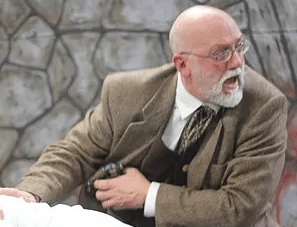Previously, on Occidental Jihadist [imagine TV narrator voice], I discussed the character Abraham Van Helsing in the novel and play Dracula. Let’s go once more to the vampires’ well, this time to examine a striking line that shows up in both Bram Stoker’s book and Steven Dietz’s stage adaptation. The former has this phrase, uttered by Dr. John Seward in regards to his sanitarium inmate Renfield: “a strong man with homicidal and religious mania might at once be dangerous. The combination is a dreadful one” (p. 87). The latter condenses Seward’s observation to “homicidal mania and religious fervor would be a dangerous combination” (p. 20).
With my academic and work background, when I first saw that line during rehearsals for the stage play I assumed that Dietz, writing in 1995, had inserted it as a comment on Islamic terrorism–which in its modern incarnation was quite active in the 1980s and 1990s. In 1983 Hizbullah Shi`i suicide bombers, with Iranian assistance, blew up two buildings housing American and French military personnel, killing 307 in total. In 1993, Sunni terrorists under the direction of Khalid Shaykh Muhammad set off bombs under the World Trade Center, attempting to bring at least one of the towers down. They failed, but killed seven people and injured hundreds. These are but the most notable of Islamic terrorist/insurgent activities prior to 1995.
Then I dug out Stoker’s novel and, as noted, found a very similar quotation. But in his time, religious terrorism of any kind was virtually unknown. He was writing right in the middle of what historians of terrorism call the Anarchist phase, which lasted from the 1880s to the 1920s. Violent anarchists were active mainly in Europe (especially Italy, Spain and France), although one did assassinate US President William McKinley in 1901. They truly embodied what Alfred told Bruce Wayne (regarding the Joker) in The Dark Knight: “some men just want to watch the world burn.” They hated all political structures, and hoped to bring them all down. But if anything Anarchists were irreligious–indeed, even anti-religion, as many of them were Marxists.
Most likely, however, Bram Stoker was taking a jab at the Crusades. The 19th century had seen the the enormous popularity of Brit Sir Walter Scott’s novels such as The Talisman, The Betrothed, Ivanhoe and Count Robert of Paris, which “painted a picture of Crusaders who were brave and glamorous, but also vainglorious, avaricious, childish, and boorish…. The worst of them were the brothers of the military orders, who may have been courageous and disciplined but were also arrogant, privileged, corrupt, voluptuous, and unprincipled” (Jonathan Riley-Smith, The Crusades, Christianity, and Islam, p. 65). Crusader-bashing was a favorite approach of Enlightenment writers, and this carried on well into the 19th century–both in Europe and in the Middle East, as Riley-Smith unpacks in his informative but slim volume.
But in the 21st century, with the Crusaders long since turned to dust like Dracula, 77% of transnational terrorist groups wage jihad in the name of Allah. So it’s clear where dangerous homicidal and religious mania resides today–and it’s not in Christianity. In this regard, Stoker has proved all-too-prescient.



